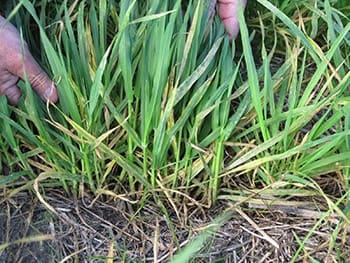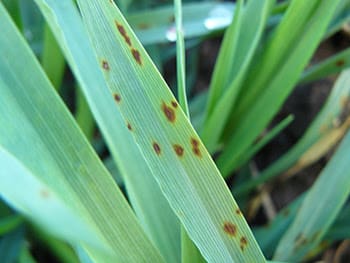GROWERS in Western Australia are urged to control foliar diseases in barley crops in coming weeks as yield potential is set up during the crucial flag leaf, upper stem and ear development stages.
High levels of leaf rust, low levels of powdery mildew, and spot and net type net blotch were reported in late July-early August to the GRDC-supported PestFax service, which is managed by the Department of Agriculture and Food WA (DAFWA).

Growers should watch for symptoms of diseases such as powdery mildew in WA barley crops in coming weeks. Photo: GRDC.
These diseases have been found on a range of barley varieties, especially across many southern grainbelt areas, prompting advice to ‘watch and act’.
DAFWA offers a disease testing/diagnostic service to correctly identify diseases prior to using fungicides.
More information is available at DAFWA Diagnostic Laboratory Services (DDLS) (formerly AGWEST Plant Laboratories) (www.agric.wa.gov.au/plant-biosecurity/ddls-seed-testing-and-certification-services).
DAFWA also has a useful crop disease risk forecast webpage (www.agric.wa.gov.au/barley/crop-diseases-forecasts-and-management) and reports of disease incidence and severity can be made to the PestFax service (www.agric.wa.gov.au/crop-diseases/about-pestfax-newsletter).
Leaf rust
Growers in the Great Southern and South Coast regions, in particular, are being urged to closely monitor barley crops for leaf rust this year.
Leaf rust is favoured by warm, moist autumn conditions and research has shown it can cut barley yields by more than 30 per cent when infections are severe.
DAFWA plant pathologist, Kith Jayasena, said despite having a relatively durable form of disease resistance, the feed variety Oxford was behaving unusually under high disease pressure this season and pre-emptive fungicide applications might be needed.
Oxford carries the adult plant resistance (APR) gene Rph 20, which tends to be effective at the adult plant stage, but he said there appeared to be current widespread leaf rust incidence in this variety.
This may be due to temperature effects that are known to influence the expression of APR.
DAFWA is recommending Oxford be treated as a susceptible variety this season and fungicides applied pre-emptively, as it is uncertain when APR genes will be activated.
A list of registered foliar fungicides for treating leaf (and stem) rust in barley in WA is available on the DAFWA website (www.agric.wa.gov.au/barley/registered-foliar-fungicides-cereals-western-australia).
Tips for diagnosing and managing barley leaf rust can also be found via this link.
Leaf rust samples from suspect crops can be sent to the University of Sydney Plant Breeding Institute (PBI) for pathotype analysis (http://sydney.edu.au/agriculture/plant_breeding_institute/).
The RustBust website (http://rustbust.com.au/) is another useful resource for information about managing barley leaf rust and can be found here.
Barley powdery mildew
Powdery mildew has been reported in barley crops in the central grainbelt and upper Great Southern in recent weeks, especially affecting the variety Bass.
Since 2012, growers in medium to high disease risk areas have seen increasingly severe levels of barley powdery mildew in susceptible varieties and a decline in control efficacy by some triazole-based fungicides (which belong to the demethylation-inhibiting (DMI) fungicide group).
DAFWA advises that the compromised triazole ingredients tebuconazole and triadimefom have reduced and potentially-reduced efficacy, respectively, and are not recommended for powdery mildew control in high disease risk areas this season.
There are other triazole fungicides that can be effective for powdery mildew control in barley crops, such as those containing the actives:
- Epoxiconazole
- Prothioconazole + tebuconazole
- Propiconazole
- Propiconazole + tebuconazole
Fungicides containing both a strobilurin and an uncompromised triazole active ingredient and amines, such as spiroxamine, can also be used confidently. As a part of the fungicide management strategy, the products with different actives are best rotated and not used for more than two applications per season.
For greatest efficacy, fungicides should be applied before significant levels of disease establish in crop and then crops should be monitored regularly.
In lower disease risk areas of WA, such as the low rainfall zones, less frequent fungicide use for powdery mildew should be needed.
If powdery mildew has not been a regular focus of disease management in previous seasons, there should be no need for prophylactic foliar spraying for this disease.
DAFWA’s tips for fungicide use include:
- Correct disease identification
- Choose fungicide according to spectrum of diseases present at any given time
- If repeated applications of fungicide are required in one season, use uncompromised fungicides in a rotation
- Always follow label directions and restrictions.
DAFWA’s crop diagnostics website page has a range of useful links and information about identifying and managing barley powdery mildew and can be found at (www.agric.wa.gov.au/mycrop/diagnosing-powdery-mildew-cereals).
Spot type net blotch (STNB) and net type net blotch (NTNB)
There were PestFax reports in late July of barley STNB incidence in the varieties Scope and Flinders in the upper Great Southern, including in a crop treated with a fungicide-based seed dressing.

Parts of WA are experiencing increased incidence of spot and net type net blotch in barley crops. Photo: GRDC.
DAFWA researchers stress that treatment with foliar fungicides (according to label recommendations) should suit the management of disease threat/s present while limiting the risks of fungicide resistance developing.
During the 2015 season, NTNB resistance to tebuconazole was detected from five different WA locations by the GRDC-supported Centre for Crop and Disease Management (CCDM) at Curtin University.
The researchers also detected a smaller reduction in sensitivity to other related fungicides, such as epoxiconazole, prothioconazole and propiconazole, from these samples.
According to Dr Fran Lopez-Ruiz, of the CCDM Fungicide Resistance Group, straight tebuconazole is not registered for the control of NTNB.
But growers should be mindful that NTNB may be present when applying tebuconazole to control other barley diseases, which may contribute to NTNB issues in subsequent seasons.
CCDM researchers will continue to monitor this disease during 2016 and growers and advisers are urged to submit suspected infected leaf samples to the CCDM (http://ccdm.com.au/) for resistance testing.
DAFWA has information about the symptoms and management of STNB and NTNB at (www.agric.wa.gov.au/barley/managing-barley-leaf-diseases-western-australia).
Source: DAFWA

HAVE YOUR SAY